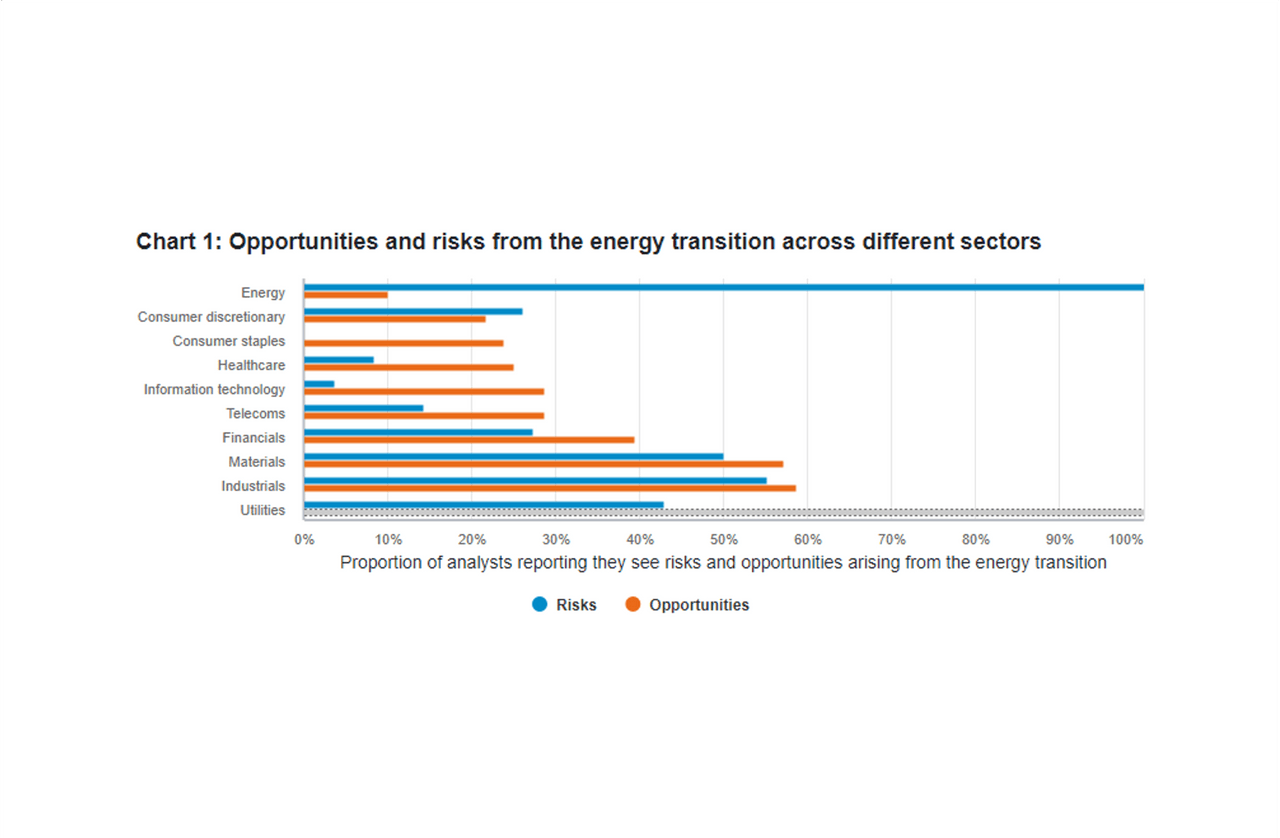Our believe the utilities sector currently enjoys the best opportunities, given the scale of investment being pumped into green energy. One fixed income analyst says that the transition could also lower the sector’s risks, as long-term renewable power contracts help utilities companies strengthen their credit profiles and reduce their cost of debt.
Perhaps unsurprisingly, energy companies face the biggest risks as fossil fuels are phased out. Yet our analysts expect these sharp differences between the two sectors to diminish over time, as utility and energy firms blur together through M&A into the clean powerhouses of the future.

Chart 1: Opportunities and risks from the energy transition across different sectors Fidelity International
Chart 1: Opportunities and risks from the energy transition across different sectors
“How significant are the risks to your companies’ current business models as a result of the transition to a low-carbon economy?” and “How significant are the potential business opportunities arising for your companies as a result of the transition to a low-carbon economy?” Scale of 1-7, where 1 is not significant and 7 is very significant. The chart shows the proportion answering 5-7 (there are risks and opportunities). Source: Fidelity ESG Analyst Survey 2021.
After utilities, our analysts believe industrials have the brightest prospects from the transition, but with the second-highest level of risk. According to one Europe-based capital goods analyst, the subsector should benefit from increased demand for renewable energy equipment and electric vehicle charging points. However, industrial companies also face risks posed by regulation, supply chain disruption and legacy businesses.
Information technology ranks in the middle of the pack, but some opportunities are emerging here too. Software will become ever more essential to managing a grid powered by renewables and batteries, while general decarbonisation requires a host of new applications. One analyst points to a forthcoming carbon calculator from a leading German developer that will help companies capture and analyse their carbon footprints.
Consumer discretionary companies offer fewer opportunities and our analysts say that the pandemic means that much of the sector remains in ‘survival mode’, with often less reason to think about decarbonisation. Cruise liners and airlines are obvious exceptions. They too are focussed on staying afloat amid Covid-19 travel restrictions but, as heavy emitters, cannot avoid the transition.
More ambitious targets are needed
While transition opportunities are on the rise, variations between company emissions reduction targets are stark. Three quarters of analysts covering Europe believe companies have the right targets in place to get them to net zero by 2050, but the figure is zero for Latin America and Emerging Europe, the Middle East and Africa.
Only half of our analysts believe companies globally are making a big effort to help the transition, although some countries are changing faster than others. Analysts say there is a six percentage-point shortfall between the amount of capex companies need to allocate to the transition and the proportion they expect them to allocate. China has the lowest shortfall, with more companies there increasing their transition-related investment after President Xi’s announcement that China would reach net zero by 2060.
Companies can help accelerate the low-carbon transition by linking executive pay to reductions in greenhouse gas emissions. Analysts report that only a third of companies currently do this, and only half require their boards to consider ESG issues. The companies that do both should be well placed to capitalise on the immense range of opportunities that will arise as the global economy gravitates towards net zero industries, while mitigating the very real risks.
Read out more on this theme on Fidelity
